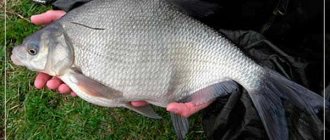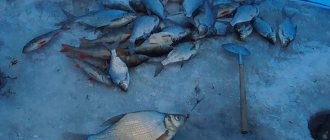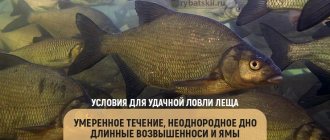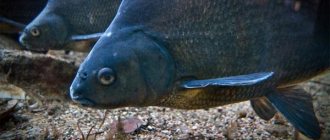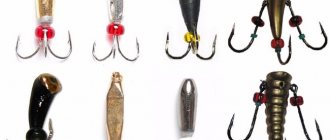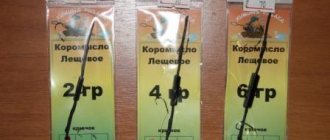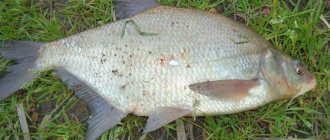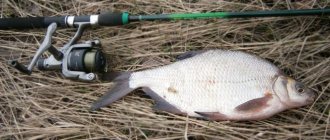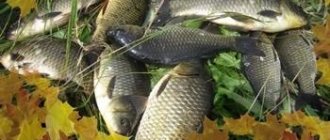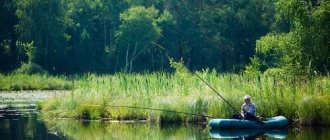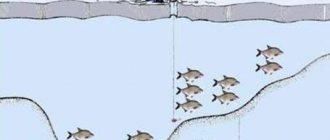Catching bream with a float rod has been practiced by fishermen for quite a long time and is one of the most popular types of fishing in our country. The emergence of new equipment and types of gear has made it possible to expand the horizons of the possibilities of using float rigs in fishing for this fish. Catching bream with a float rod has become much more interesting and successful, since modern rod materials have increased the reliability of the equipment and at the same time made it more delicate, which is more attractive to the fish. Fishing at long distances and strong currents can be done without any problems due to the specific equipment used and the use of special types of rigs.
A wide range of baits with a variety of scents attractive to bream schools is available for purchase in every fishing store, and innovative baits in the form of boilies, on par with traditional classic baits, give the angler hopes to receive only large trophies as credits during fishing sessions. All these arguments and opportunities cannot but encourage a real fisherman to go to a reservoir in order to organize bream fishing, especially since this fish is common in almost all rivers, reservoirs and lakes in our territories. The information obtained as a result of reading the presented material will help you prepare more rationally, and therefore more scrupulously, and catch bream with a fishing rod, being satisfied with the process itself and, of course, with the catch received.
Rod selection
Float tackle for bream can be assembled on four types of fishing rods, which include fly, match, Bolognese and plug rods. Preference for a certain type of gear is given purely based on the expected fishing conditions, namely the distance of bait supply, the speed of the current in the fished body of water, the depth of fishing and the activity of fish. Let's consider the parameters of each type of fishing rod with a focus on catching bream.
Fly fishing rod
The fly rod is selected in a telescopic assembly version without the presence of winding rings. Carbon fiber or carbon fiber fishing rod material is preferable due to the light weight of the product. When planning to catch bream from the shore, select gear from 5 to 9 meters long. If fishing is done from a boat, a length of 4 meters is sufficient. The tips of the fishing rods on the last link are necessarily equipped with a connector for attaching fishing line, which simplifies quick changes to the required installation conditions. As a rule, a test of 30 grams is enough for comfortable fishing both on currents and in still waters.
Match tackle
The match is used for hunting trophies at long distances and when the depth at the fishing site exceeds five meters. Prefabricated plug forms 3.5-4.5 meters long work effectively. The action of the stick is preferably medium and slow, which when hooking guarantees the preservation of the delicate lips of the fish and further reliability when fishing. The test range of gear rarely exceeds the parameter of 15–20 grams, which is enough for comfortable long-distance casting of thin and light equipment.
Bologna rod
Bolognese tackle is used in sizes of 6–7 meters with an average diameter ring size, which reduces the possibility of clogging of holes when winding fishing lines, floating aquatic vegetation and mud clinging to the cord. Tests up to 25 grams are always more than enough for all types of baits and workloads of installations. Just like with the swing, they try to take the bologna in a carbon-fiber version, which significantly reduces the load on the hands when conducting this dynamic fishing.
Bream tackle for fishing from the shore
When fishing with a float rod with a “blind” rig, the winner is often the angler who, through trial and error, is able to choose a tackle for himself where the errors of individual elements are minimized.
The main element is the fishing rod. The casting range and accuracy, the softness of the hook, and the degree of shock absorption during jerking and landing fish depend on its characteristics.
For catching bream from the shore, the most suitable rod is of medium hardness, which allows you to deliver the bait to the feeding area without any problems, not only in calm conditions, but also in side and head winds.
However, it should be borne in mind that the stiffer the fishing rod, the thicker the main line and leash have to be installed. And this, as a rule, slightly reduces the number of bites.
The disadvantages of soft rods include the inability to cast accurately and the unpredictable behavior of the rod tip when hooking.
So, how to choose equipment so that when casting and presenting the bait it does not arouse suspicion in such a cautious fish as bream.
It is well known that fish often have to be caught using baits lying on the bottom. And this, in turn, determines the choice of float design and optimal loading options. Because an inappropriate garland of sinkers can alert the bream. The chances will increase if you use two sinkers - one, the main one, located 20 centimeters from the bait, and the other, which lies directly on the bottom and is 10 centimeters from the bait.
But the main thing is to properly surround the float, preferably at home. The bream float is loaded so that the main sinker completely drowns its body. The weight of the under-shepherd is selected so that in the working position the long antenna extends only 1-2 millimeters out of the water.
Bream is a tall-bodied fish. To take the bait from the bottom, it takes an inclined position. Raising the bait slightly, the bream savors it for a while. Then it becomes horizontal and begins to move to the side and to depth. At this time, the float rises, most of the antenna comes out of the water, signaling us about the progress of the bite. This loading method is also called the “lift method”.
These are the basic requirements for catching bream from the shore with a float rod with a “blind” rig.
Float tackle for long casting
Usually it helps out the fisherman when the bream feeds away from the shore or for some reason ignores the coastal zone (for example, when fishing on a flat bottom, where the depth does not exceed 2-3 meters).
In this case, the rod with rings is equipped with a spinning reel, which allows you to cast tackle up to 30 meters or more. The sliding float can have one or two attachment points. Most floats for long-distance casting are made with internal weighting. When fishing for deep-sea fish, including bream, their carrying capacity is from 5 to 15 grams. The upward movement of the float is limited by a stopper knot, which is knitted from a thicker fishing line than the main one, or by a magazine stopper.
Tips for a fisherman: Do-it-yourself bite alarm for a bottom fishing rod - Tips for a beginner
The advantage of long-casting gear is that at a distance from the shore, the bream takes the bait more decisively and boldly. The downside is that it is difficult to feed the point. And also with an increase in the weight of the load, the sensitivity of the gear is lost.
The rod is usually selected as long as possible, taking into account the specific fishing conditions and physical strength of the fisherman.
Coil selection
An important element of equipment is the competent and harmonious selection of reels. Inertia-free reels with fine adjustment of the friction brake on the back of the mechanism body are convenient to equip, which allows you to adjust the braking parameters of the cord even during the fishing process. In bream fishing, the pulling force of a reel is not so important. More in demand in practice is the high transmission frequency of the mechanism, which is expressed in the high speed of winding the cord, and, consequently, in the subsequent speed of re-casting the equipment, which is especially felt when carrying out wiring over long distances and in strong currents.
The spools are suitable for medium capacities. Mono lines of 0.2-0.25 mm do not take up large volumes and on cone-shaped line catchers they work more efficiently during reeling and casting. Reels are used for catching bream using match and Bolognese fishing rods. Mach and plug are not included with the presented accessory.
Lures and groundbait for bream
For successful fishing, bream, like other fish, should be fed in the future fishing areas. In this case, you can use both plant and animal baits, or artificial, synthetic compounds.
Tips for a fisherman: How to make a fishing rod for winter fishing - Answers for beginners
Vegetable baits
- With regard to vegetable complementary food and bait for bream, it can be corn and pearl barley, peas or dough, up to pasta and boiled potatoes, or simple wheat bread crumb.
- But as experienced fishermen note, when catching bream, it is best to make a “sandwich” on your hook. First, they put a corn grain on a hook, then a star-shaped pasta and 1-2 maggots on top - many people use this bait to lure picky inhabitants of rivers and reservoirs.
Animal bait
If possible, it is best to catch bream either with a mixed bait, as described above, or use animal bait.
And this can be:
Artificial baits
Of the artificial baits, it is optimal to use crumbled polystyrene foam, used as an independent bait and to raise the hook to the surface of the water.
In addition, it gives the hook vibrations that are attractive to bream, which is especially effective when the water is flowing.
Ready-made bait for bream can be purchased at any fishing store. But some bream farmers prefer to prepare the feed mixture themselves.
Equipment of a float rod for bream
The equipment of a float rod for bream is assembled on monofilament cords using standard and non-specific fishing accessories. The main criterion for fishing success is the fisherman’s ability to design thin rigs that are not overloaded with elements, capable of disturbing the fish as little as possible when familiarizing themselves with, tasting and eating the bait. In tying rigs, the use of swivels and fasteners, massive weights and rough floats is omitted. They try to connect the elements of the mounting parts by direct contact, using strong knots that prevent self-unraveling. We will devote further conversation to a specific analysis of the parameters of the main elements and details of the equipment of a fishing rod for bream.
Float selection
The shapes of floats are selected based on the strength of the river current. For fast flows, flat samples are used that cope well with the loads from current jets. In still waters, spindle-shaped alarms perform well. All types of floats are equipped with a tall but thin antenna, preferably with a boss at the tip.
Important! The antenna is painted zonally, in bright, distinctly different colors. This nuance helps to load the product competently and subtly, visually focusing on the immersion levels.
Depending on the magnitude of the wind load and wave, the mass of the float is selected. Strong winds and waves force the use of heavy forms of signaling devices of 3–5 grams. Calm weather and small ripples make it necessary to use light float options, ranging from 0 to 1.5 grams. The less stable the bite, the less mass the floats use. Balsa is considered the best material from which bream alarms are made.
Read how to tie a float to a fishing line in different ways.
Loading
Loading with different-sized pellets always brings the greatest effect when balancing equipment. They make it spaced out using a pad at the leash attachment point. Large shot is placed closer to the float, moving towards the leash with a decrease in the mass and volume of the load. In match equipment, they actively use the possibility of placing a load directly in the float structures, which makes casting further and more accurate, and the supply of bait to the required water horizon level without unnecessary noise.
Hook selection
The choice of hook for bream is carried out based on the type of bait used. The size of the nozzle directly affects the accessory number. Thus, animal bait in the form of a bunch of worms needs a hook number 6–8 with a long shank. Maggots, bloodworms and caddis flies are mounted at 12–14. All kinds of plant baits are strung on numbers from 8 to 14 inclusive. The forend for the attachments described above is used in a shortened version, and the sting is selected with a bent tip inside the bend radius of the hook. With these types of hooks, baits rarely come off when casting and are more difficult for fish to pull in when they bite. The choice of hook color directly depends on the color of the bait.
Important! The universal bream hook color is blue and its shades.
The design of the connecting element of the hook or shank does not play a special role in the selection. Its choice depends on the angler’s ability to reliably connect the hook with a certain type of knot to the leash line (read more about how to place two hooks on a float rod).
Fishing rod with equipment for bream
Many fishermen use universal telescopic or plug-in rods with rings and equipped with a spinning reel. Typically 3.5-6 meters long, these rods are very strong and have good action for accurately casting a float with a strong swing far from the boat or shore. For long casting, you have to use a heavy fixed or sliding float, which creates a significant splash and noise on the water, and when catching bream with a fishing rod, this is bad, since this fish is very careful and is afraid of noise. Therefore, if the structure and test of the rod allows you to use a light float, for example, like a gooseneck, for long-distance casting, then this will be the best option.
The most common, high-quality, spinning-free reel of size 1000-2500 is suitable for a fishing rod rigged for bream, but the line on the spool must be laid tightly and under the very top edge of the spool, so that it easily flies off the spool. The fishing line for equipping the reel can be taken with a diameter of 0.20-0.25 mm. And after the sinker, it is better to make a leash from a fishing line with a diameter of 0.12-0.16 mm and a length of 20-25 cm. A leash that is too long makes the bite almost unnoticeable, this is due to the peculiarities of catching bream with a float rod. In rigging for bream, the sinker for loading the float, naturally, must be selected in accordance with the weight of the float and preferably an oblong shape, rather than round or flat, so that there is less noise when casting.
At the end of the fishing line, it is better to tie a hook for rigging bream; it must be of high quality and very sharp, hook number 6-10 (according to Russian numbering) with a long shank. A hook with a long shank is good to use if the bait for bream is a bunch of worms or crawlers. And if you use peas or corn for the bait, then it is better to take a hook with a short shank and be sure to be very sharp.
Some fishermen, when catching bream with a fishing rod with a float, use a fly rod 5-8 meters long without a reel, tying the line directly to the tip of the rod. The length of the fishing line in this type of bream rig is adjusted to the size of the fishing rod, so that it is convenient to place the bait on the hook. And also to make it convenient to pull out the catch, holding the rod in one hand, and with the other hand you can easily take the caught fish. Fishing with a long fly rod is good in a pre-fed place with a predetermined depth, casting almost to one point, without wasting time winding the line onto the reel.
And also re-casting the bait occurs quickly and accurately. This method is quite quiet and does not scare the fish, since a light float can be used, and when casting for bream, such equipment will not create much noise, which is very important when catching bream with a fishing rod. It is good to fish with a long rod from the shore, not overgrown with trees and bushes, or from a boat in an open space, so that nothing prevents the fisherman from handling the long rod.
Features of the gear device
Features of the gear design can be characterized by basic concepts that should be adhered to during assembly. These include: selecting the lightest possible version of the fishing rod in combination with its high strength, knitting a sensitive assembly with the smallest inclusions in its composition of elements that are ineffective and have little effect on the fishing process, the use of oversized, unobtrusive tackle, which is most adapted to certain conditions catching Following the above criteria, the fisherman will be able to independently develop a universal mechanism for assembling a bream fishing tool, rational and effective in all areas of its practical application.
Nozzles
Bream is an omnivorous fish, and this only benefits the angler. After all, the field of vision of the baits is expanded to a large extent, therefore the chances of successful fishing are significantly increased. Like most fish species, bream in cold water prefer to eat the animal component in their diets, switching to plant nutrition in the summer months in warm water. Breams have no particular preferences when it comes to choosing baits. He is not a gourmet in narrow directions and responds well to widespread and accessible baits, which we will consider based on their type below.
Vegetable origin
Among plant baits, bream prefer cereal grains in various cooking methods. Steamed wheat, oats, we’ll also include whole peas, boiled pearl barley – bream’s favorite baits. Young potatoes in small, slightly undercooked tubers are also a desirable delicacy for fish. Sweet canned corn is gaining more and more popularity as a promising bait among breams. Dough made from semolina and rye grain in the form of mastyrka and mamalyga is no less successful. Medium-diameter boilies are also beginning to confidently enter the arsenal of bream baits.
Animal origin
A bunch of dung worm with enviable consistency occupies the leading position of the classic bream bait. You can catch bream on a fishing rod using bloodworms, maggots, caddis flies, chafers during the periods of their emergence, as well as fresh meat from toothless shells. Mixing baits such as maggot-bloodworm, maggot-corn, bloodworm-barley, worm-corn has a positive effect on the bite.
Important! Sandwiches make it possible to quickly determine the preferences of fish at the time of fishing and thereby obtain more significant results.
Lure
The most successful basis for bait is considered to be boiled millet porridge, a mixture of which with other ingredients is brought to the required consistency for the fishing conditions. Vanilla breadcrumbs and sunflower cake are added to the viscous porridge. Depending on the bait, the compositions include crushed boiled peas and canned corn or potatoes of the same type. Animal components are added only when fishing in cold water in spring and autumn. The worm is cut with scissors, and the bloodworms and maggots are placed whole into portions prepared for casting. Attractants in the form of vanilla, cinnamon and cocoa are added in small quantities to create only a light and unobtrusive odor. It has been noticed that added coffee cake, a by-product of coffee machines, causes increased interest in the fishing spot for trophy fish.
Important! For currents, soil or sand is added to mixes to make the mixture heavier. In standing waters, absolutely pure compounds are used.
Choosing a fishing spot
Bream lives both on currents and in still water, preferring depths of over 3 meters. Loves clean and hard soils made of clay or coarse sand. Avoids silted areas with mud and heavy thickets due to high sensitivity to oxygen content in water. Let's consider approaches to determining fishing sites based on the types of reservoir.
Fishing on the current
Catching bream with a fishing rod in the current is possible on river beds, in places above edges and depth changes, ledges descending to the bottom and sharp cliffs and walls. Places where the current slows down near whirlpools and steep coastal cliffs are often also stopping points for schools of bream. In the hot summer months, at night the fish approach the shallows, and during spawning in May and June, they enter shallow and calmer backwaters, where they stay after spawning for the next 7–10 days.
Fishing in still water
In still water, bream are searched for in holes that are the largest in depth for a reservoir. It is not uncommon to catch bream at horizons of 15–20 meters on reservoirs and lakes with such relief. At shallow depths, bream are searched for in ditches starting from three meters, fishing for slopes of changes in depth. In these conditions, a float for bream is used of a sliding type, trying to catch it with a match from the shore or with Bolognese tackle from a boat.
Poaching tackle floating feeder for carp and crucian carp.
⌚ — 9 minutes 16 seconds
Fishing on the river with a float One kilogram ide, bream, Cool! Catching bream with a fishing rod
⌚ — 17 minutes 39 seconds
BY ADDING THIS TO THE MAGGOG, ALL FISH BITE BETTER!!
⌚ — 1 minute 43 seconds
ALL FISH ARE GATHERED FOR THIS BAIT WITH CHERRY FLAVORS, from crucian carp to bream
⌚ — 4 minutes 48 seconds
FISHING on the FEEDER in a STORM!!! LIGHTNING STRIKED INTO THE RIVER and BREAM TOOK HEMP GRAINS
⌚ — 27 minutes 51 seconds
Catching Bream on a Float in Summer. Did you catch Bream?
⌚ — 17 minutes 45 seconds
Large tench and black bream on a float in the reeds, fishing on a rural pond
⌚ — 33 minutes 37 seconds
Fishing with a float IN THE DEBERS OF A FOREST CREEK!! Fishing 2021, bream, roach, perch.
⌚ — 26 minutes 43 seconds
70 kg of bream on a float in 6 hours, this is too much even for me, report No117
⌚ — 57 minutes 17 seconds
FAVORITE porridge BAIT for CATCHING BREAM on the RIVER on the FEEDER for the SPRING FEEDER and WATERMELON, PSHONKA!
⌚ — 3 minutes 10 seconds
MY BEST FISHING FROM BOAT 2021. ROACH AND BREAM ON A FLOAT - SOUL FISHING.
⌚ — 42 minutes 49 seconds
POPLA-POPPER or Float? Catching tackle for catching white fish on a spinning rod. Travyanskoye Reservoir
⌚ — 12 minutes 6 seconds
Fishing on the Kocheta River KRASNODAR region! Cupid, crucian carp, perch, bream on a float rod!
⌚ — 22 minutes 52 seconds
One kilo bream on a float! This is fishing!
⌚ — 13 minutes 32 seconds
Bream fishing in summer 2021! I didn't expect such a bite! Catching bream in the summer with a donk and a feeder!
⌚ — 16 minutes
Bream on float | Fisherman's Planet
⌚ — 24 minutes 27 seconds
DO NOT FEED BREAM WITH THIS! HE'S NOT A PIG AND HE DOESN'T EAT THAT THING! AND THERE WILL NOT BE!
⌚ — 8 minutes 2 seconds
FISHING FOR BREAM FIRST TROPHY! CATCHING BREAM WITH A FISHING ROD ON THE RIVER IN THE HEAT
⌚ — 6 minutes 41 seconds
Tags:
By dates: 06/30/2021 - 07/01/2021 - 07/02/2021
Commented video:
BEST TIK TOK VIDEOS 2021 | TIK TOK FUN | TIK TOK TRENDS
⇒ “Not very funny... So-so.
It can be better. But in view of the fact that humor is now strained, it will do. Or maybe there’s something wrong with my perception. It's rare to like humor. But I don’t want to be a grump - so the author doesn’t care - respect. Still, I tried my best to cheer up the people, I was lifted up..." View in full... Added - 07/01/2021 18+ Video from an eyewitness of the bus accident in Sochi
⇒ "It was very scary to watch these footage, children crying, screams, I’m afraid to even imagine the horror they experienced passengers.
It is also, of course, very interesting who caused this accident, the impact was probably very strong, since the bus fell on its side, the most important thing is that it would have happened without..." Watch in full... Added - 07/01/2021 Korea d 9, - Watch online
⇒ "Very dynamic and exciting!
It was as if I had ridden a bicycle myself. It’s sunny, cats, you can hear Russian speech in the background! Dedicated bike paths and beautiful buildings. Thanks for the review. I’ve always dreamed of visiting Korea, a unique and culturally rich country, but in today’s ..." Watch in full... Added - 07/01/2021 Hydrolysis of salts formed by a strong base and a weak acid
⇒ "Good video.
The coloring of phenolphthalein in an alkaline medium is shown. You can add pH determination using universal indicator paper and determination of the numerical pH value.” View in full... Added - 07/01/2021 “Money in 17 seconds” - an exercise that increases your income |
Marta Nikolaeva-Garina ⇒ “As a person who is interested in Feng Shui and reads a lot of literature about positive thinking, this video should have been interesting.
However, it was absolutely disappointing. It’s stupid to hope that by repeating ten times my income will double, it will immediately increase...” See in full... Added - 07/01/2021 A girl saved a dog from icy water
⇒ “Why do you think that no one would take risks for the sake of a dog? Of course, men and women are 2 different planets, but even among men there are normal people, if there is compassion, conscience, pain for the torment of the poor thing, because everyone is in pain, everyone wants to live, cows cry when they are led to the slaughter, they ... " View in full... Added - 07/01/2021
Fishing process
We catch bream with a float rod in a pre-fed place, be sure to maintain silence, throwing out the gear before dawn. The bait is carried out or kept as close to the bottom as possible, placing the bait so that it lies on the ground or touches it when retrieving. After feeding, the approach of the flock can take up to a couple of hours. The bream bites themselves are cautious and inconspicuous.
Important! Catching bream with a fishing rod at night should be accompanied by the possibility of illuminating the float antenna.
After active swaying, the float moves to the side or lies on its side - this is the moment of hooking. The hooking is done smoothly, fearing that the bream’s lip will break during a sudden movement. The fish that takes the bait tries to go to the bottom, initially offering strong resistance.
